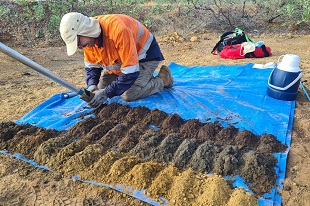
NTGS commissioned the Mine Waste Transformation through Characterisation (MIWATCH) research group, part of the Sustainable Minerals Institute, University of Queensland to characterise mine waste at selected sites with focus on secondary prospectivity for critical minerals. This project is forms part of the Geoscience Australia led National Atlas of Mine Waste.
The first two records focus on Mount Bonnie–Iron Blow (currently operated by PNX Metals Ltd) and Brocks Creek (Bacchus Resources Pty Ltd) in the Pine Creek Orogen. These studies focus on first-pass characterisation of mine waste to assess the potential for previously unconsidered critical metals endowment.
Mount Bonnie waste material (pit ore, ROM, waste rocks and tailings) shows abundant concentrations of critical metals such as bismuth, indium, antimony, tin, tellurium and zinc and enrichment in metals such as silver, gold, copper, molybdenum and selenium. Bulk-rock geochemistry of Iron Blow pit ore and waste rock specimens reveals relative enrichment in critical metals such as bismuth, dysprosium, indium, manganese, antimony, tin, tantalum, terbium, tellurium, tungsten and zinc and abundant metals such as silver, gold, copper, molybdenum, lead and selenium. Tellurium and gold identified in the Brocks Creek tailings are at concentrations greater than 100 times the average crustal abundance; other metals, such as bismuth, antimony and silver are also relatively abundant, greater than 10 times the average crustal abundance. Recovery methods for both sites, including bioleaching and conventional flotation methods are discussed.
Download NTGS Record 2023-014: Assessment of mine waste secondary prospectivity: Brocks Creek and NTGS Record 2023-015: Assessment of mine waste secondary prospectivity: Iron Blow and Mount Bonnie through GEMIS.




